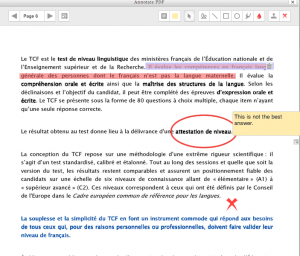by Steve Taylor
One of the findings of research into learning and student behavior is that many under-performing students are over-confident in their mastery of their material. Over-confidence leads to inadequate studying. One remedy is to provide students with frequent opportunities for assessment. These opportunities don’t have to be in the form of time-consuming exams. They can be quick, ungraded assessments, whose only goals are to let students know if they really know what they think they know. If you’re worried that adding frequent assessments will eat away at your class time and add to your own workload, you may find some relief in technology. Here are two techniques.
Moodle Quizzes
One way is to create short, ungraded, auto-corrected quizzes in Moodle (or whatever Learning Management System you use.) Since students can take them out of class, they won’t affect your in-class time. And if they’re multiple-choice, or some other objective-answer format, you can designate the right answer so that Moodle can tell the student how well he or she did. Keeping them ungraded removes any temptation for the student to cheat. This is important, because the assessment has to be genuine— devoid of any self-delusion— in order to be effective. It also means that you don’t have to worry about honesty issues.

Not many Vassar instructors make use of Moodle-based quizzes. That may be partly due to the fact that they take some effort to create, but also to the fact that a multiple-choice quiz may not seem to be a valid measure to base a grade on. But it may be just valid enough to make students re-think whether or not they’ve studied enough.
 Clickers
Clickers
Another way to conduct a quick, ungraded quiz is to do it in class, with clickers. Clickers (known more formally as Audience Response Systems) are small, handheld devices that each student in a class can use to instantly submit an answer to a multiple-choice question. In most cases, their use is anonymous. They may take up no extra time in your class, because you probably already do frequent comprehension checks in class, by asking “Is that clear? Does everyone understand that? Can we move on?” The problem with that method is that most people will mumble assent, whether they understand the material or not. Who wants to be the one person in class who says that they don’t get it?
 One student may not want to admit that he doesn’t understand the material; another may think she understands it, but be wrong. A quick quiz will address both problems. And besides letting students know where they stand, it may also let you know if you need to spend more time on the topic or if you can move on.
One student may not want to admit that he doesn’t understand the material; another may think she understands it, but be wrong. A quick quiz will address both problems. And besides letting students know where they stand, it may also let you know if you need to spend more time on the topic or if you can move on.
A clicker system will display your question on the projection screen, collect everyone’s silent, anonymous answers, then display the results as a graph. The results may be surprising to everyone.
ACS has a set of clickers that can be borrowed as needed.
 With the recent upgrade to Moodle 2.6, instructors have a new function available: If a student uploads an assignment in the form of a PDF file, the instructor can make various types of annotations to the file directly within Moodle. Previously, they would have to download the file, use some program that provided annotation functions, then upload that revised version to Moodle, for the student to download. Now that can be done within Moodle.
With the recent upgrade to Moodle 2.6, instructors have a new function available: If a student uploads an assignment in the form of a PDF file, the instructor can make various types of annotations to the file directly within Moodle. Previously, they would have to download the file, use some program that provided annotation functions, then upload that revised version to Moodle, for the student to download. Now that can be done within Moodle.



